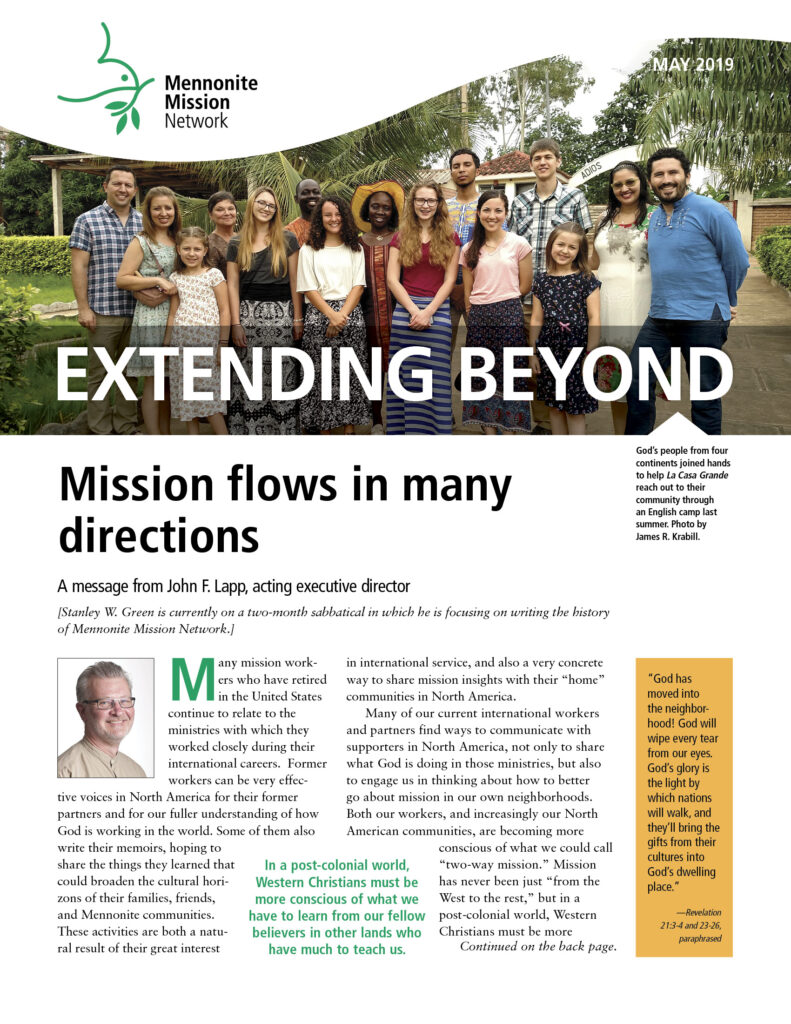[Stanley W. Green is currently on a two-month sabbatical in which he is focusing on writing the history of Mennonite Mission Network.]
Many mission workers who have retired in the United States continue to relate to the ministries with which they worked closely during their international careers. Former workers can be very effective voices in North America for their former partners and for our fuller understanding of how God is working in the world. Some of them also write their memoirs, hoping to share the things they learned that could broaden the cultural horizons of their families, friends, and Mennonite communities. These activities are both a natural result of their great interest in international service, and also a very concrete way to share mission insights with their "home" communities in North America.
Many of our current international workers and partners find ways to communicate with supporters in North America, not only to share what God is doing in those ministries, but also to engage us in thinking about how to better go about mission in our own neighborhoods. Both our workers, and increasingly our North American communities, are becoming more conscious of what we could call "two-way mission." Mission has never been just "from the West to the rest," but in a post-colonial world, Western Christians must be more conscious of what we have to learn from our fellow believers in other lands who have much to teach us.

Mennonite Mission Network has been involved in multidirectional mission for more than a century, but the concept became more explicit when Edwin and Irene Weaver took lessons learned in India to test a new mission stance in West Africa in the 1960s. Photo courtesy of Mennonite Church USA Archives.
Mennonite Mission Network has been promoting two-way mission for more than half a century, starting with Edwin and Irene Weaver, who took lessons learned in India to test a new mission-stance in West Africa. The Weavers often wondered who was the learner and who was the teacher as they studied the Bible with African believers. About the same time, mission workers in South America were moving off mission compounds to seek more culturally appropriate ways of engaging with communities around the good news of Jesus Christ. Willis Horst co-authored Mission Without Conquest recounting this endeavor.

People from four countries—Benin, Colombia, Spain, and the United States—gathered together on the porch at La Casa Grande for singing and prayer during a Youth Venture service-learning experience in 2018. Photo courtesy of James R. Krabill.
In a ministry like La Casa Grande in Benin, West Africa, mission workers are coming from settings as diverse as secular Spain in Europe, urban Colombia in Latin America, and from various ethnic communities in the United States. They bring their unique cultural lessons to share with La Casa Grande’s community. But, as Diana Cruz observes, mission workers learn much from Benin’s culture and from the Beninese children they love so much.
With such a wide range of international "aunties and uncles" learning lessons in this context, the potential is not just for two-way mission, but for three- and four-way mission—many people around the world will learn from these children as the mission workers share their stories with their sending communities.
John F. Lapp
Senior Executive for Global Ministries
Acting Executive Director

